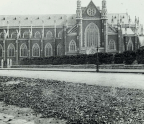The nightman
Jun 01, 2022
3 minutes
By Margaret Anderson, Director, Old Treasury Building
arly Melbourne lacked an underground sewerage system. Instead, residents disposed of their toilet waste, or ‘nightsoil’, in a cesspit – a simple hole in the ground lined with bricks. Cesspits were not ideal. Few were completely watertight, allowing sewage to seep and pollute wells and water supplies. They were also dangerous – children are known to have drowned in cesspits, and workers emptying them could be overcome by noxious gas. Two men, John Raine and his son, John, died in 1875 when working on a cesspit in Melbourne. At a
You’re reading a preview, subscribe to read more.
Start your free 30 days



